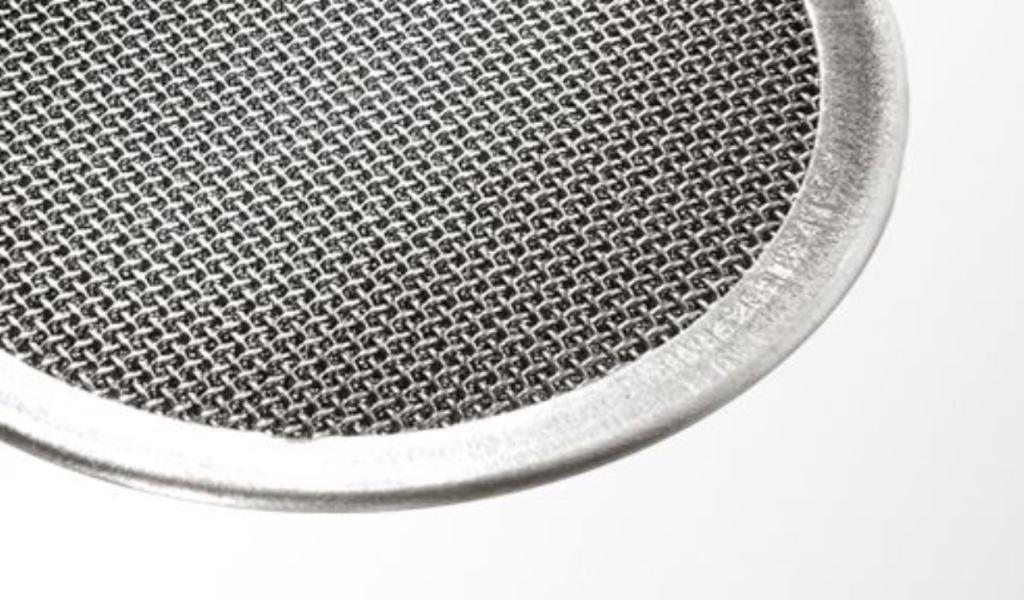Optimizing Chromatography: Woven Wire Mesh vs. Metal Fiber Felt
Chromatography is the cornerstone of precise chemical refinement and pharmaceutical purification. The foundation of an effective chromatographic process?
Choosing the right filtration media.
With prominent options throughout the industry, such as woven wire mesh and metal fiber felt, understand the distinct properties of each option available to you. This understanding will ensure precise and efficient chromatography separation, especially when you consider that each offering presents its own list of advantages and disadvantages.
At W.S. Tyler, we strive to leverage our 150 years of wire weaving experience to empower chromatography professionals with insight that will help them make informed decisions.
With this in mind, we wrote the following article to highlight the key differences between wove wire mesh and metal fiber felt, breaking down how each can fit your chromatography process. It will cover:
- The definition of woven wire mesh
- The definition of metal fiber felt
- The benefits of using woven wire mesh in chromatography
- The benefits of using metal fiber felt in chromatography
- A side-by-side comparison of woven wire mesh and metal fiber felt
- How to choose the right filter media for your process
What Is Woven Wire Mesh?

Woven wire mesh is a filter medium crafted by interlacing hundreds of metal wires until a precise, grid-like weave pattern is formed. Offering notably superior mechanical strength, dimensional stability, and customization, wire mesh is known for its ability to deliver dependable performance in high-pressure chromatography systems.
Want to know more about the weaving of woven wire mesh? Read the article below:
Wire mesh is particularly popular because virtually every aspect can be tailored to your system. You have complete control over parameters such as mesh count, wire diameter, aperture size, weave type, weave thickness, alloy, and percentage of open area.
When properly balanced, these specifications contribute to the material's ability to deliver peak durability, corrosion resistance, flow distribution, and cost efficiency.
What Is Metal Fiber Felt?

Metal fiber felt is a porous filter media constructed from metal fibers that are compressed and sintered to create a non-woven, three-dimensional bond. Its random structure orientation affords high porosity and a desirable ability to filter/separate fine particles.
This translates to peak performance when integrated into applications that call for high permeability and harsh environments.
Known for its thermal resistance, metal fiber felt is widely used for its chemical compatibility and performance when subjected to extreme operating conditions. This makes the material particularly invaluable to complex separation processes that need enhanced filtration accuracy and reduced downtime.
The Benefits of Woven Wire Mesh in Chromatography
The uniform pore openings of woven wire mesh allow the material to offer optimal filtration efficiency, affording ideal particle retention for chromatography applications. Its metal construction delivers the durability and mechanical strength needed to withstand high-pressure and abrasive operations.
Its unique properties allow for multiple cleaning cycles without sacrificing performance, ensuring ideal reusability and service life. This, in turn, reduces the expenses associated with frequent replacement and downtime.
High flow rates alongside minimal pressure drop mean woven wire mesh can enhance the efficiency of your chromatography system. Its level of customization (aperture, mesh count, etc.) makes it highly adaptable to most proprietary system requirements.
Furthermore, wire mesh offers a chemical and thermal resistance that allows it to maintain peak performance and not break down, even when subjected to aggressive solvents, extreme temperatures, and intense cleaning procedures.
These benefits combined make wire mesh a dependable option for demanding chromatography filtration.
The Benefits of Metal Fiber Felt in Chromatography
The three-dimensional properties of metal fiber felt effectively retain fine particles. This makes it a suitable solution for chromatography applications that rely on precise separation. The random arrangement of the sintered wires provides adequate performance when applied to systems that subject the material to low—to medium-pressure loads.
Supporting ideal chemical and thermal resistance, metal fiber felt maintains desirable performance in chromatography applications that process standard solvents and temperatures.
Not to mention, metal fiber felt is regarded as a budget-friendly option as it has a low upfront cost. Its affordability makes it perfect for applications that favor cost-effectiveness over long-term performance.
Woven Wire Mesh vs. Metal Fiber Felt in Chromatography: A Comparison
Gaining a comprehensive understanding of the strengths and limitations of woven wire mesh and metal fiber felt is key to achieving peak separation and performance. When selecting a filter media for chromatography in particular, it is important that you are mindful of the material's filtration efficiency, durability, reusability, cost, flow efficiency, and customization.
Filtration Efficiency
Woven wire mesh is outfitted with uniform pore openings that help deliver unparalleled filtration precision. As a result, accurate and repeatable particle retention is possible.
In contrast, despite being capable of capturing fine particles, metal fiber felt does not have the pore uniformity needed to maintain optimal filtration efficiency. In turn, this causes inconsistent filtration performance.
Durability
Woven wire mesh is crafted to deliver optimal mechanical strength to high-pressure systems. This empowers it to combat deformation and maintain desirable performance in abrasive and extreme conditions.
Offering only moderate strength, metal fiber felt is best suited for low to medium-pressure systems. Though it can handle higher pressure, when the filter is subjected to high pressure for prolonged periods of time, compaction or deformation may occur.
Reusability
When it comes to reusability, woven wire mesh stands out because it can withstand multiple cleaning cycles without losing its high-performing qualities. This versatile medium is perfect for applications that require long service life and minimal downtime.
Looking for tips on how to best maintain your woven wire mesh chromatography frit? Look no further:
The inconsistent fiber orientation of metal fiber felt renders its reusability limited. Contaminants easily get lodged in the material permanently. Repeated cleaning of metal fiber felt can lead to degraded filtration efficiency, causing frequent replacement.
Cost
Metal fiber felt offers a low initial cost that is favored by budget-sensitive operations. However, as stated above, its high replacement rate can lead to increased downtime.
This ultimately translates to increased costs in the long term.
The customization, material, and labor that goes into the weaving process of woven wire mesh leaves it with a much higher upfront cost. That being said, its durability and long service life can lead to a lower total cost of ownership.
Flow Efficiency
The open characteristics of woven wire mesh promote high flow rates while minimizing pressure drop, which can prove critical when attempting to optimize chromatography processes.
Metal fiber felt's less precise pore structure is more vulnerable to pegging, which will gradually reduce flow rates and impact overall system performance.
Chemical Resistance
As it can be fabricated using a wide range of alloys, woven wire mesh provides superior resistance to the aggressive solvents used in chromatography. This allows it to maintain its structural integrity and filtration capabilities when subjected to prolonged exposure to such solvents.
Metal fiber felt delivers desirable chemical resistance, though not as good as woven wire mesh. This means that it may degrade faster, especially when used outside standard conditions that utilize harsher solvents.
Thermal Resistance
Woven wire mesh excels when exposed to extreme temperatures. This makes it perfect for chromatography applications that utilize high-temperature solvents or sterilization processes.
Metal fiber felt is similarly equipped to handle a large range of operational temperatures. However, due to the possibility of dust and other particles reacting with the sintered bonds, it is not always recommended to use metal fiber felt for extremely hot applications. This makes metal fiber felt less robust when introduced to high-temperature environments.
Customization
Woven wire mesh gives engineers complete control over virtually every specification, empowering them to tailor the material to their specific chromatography system. These extensive customization options include mesh count, wire diameter, and pore size.
Metal fiber felt is far less customizable. Fewer specification variations are available due to the sintering process, making it harder to meet specialized requirements.
Choosing the Right Material for Chromatography Filtration: Woven Wire Mesh or Metal Fiber Felt
When optimizing your chromatography filtration system, the choice between woven wire mesh and metal fiber felt depends on several factors. These include your application's specific needs, desired performance, and, of course, your budget.

When Should I Choose Woven Wire Mesh?
Woven wire mesh will best suit your needs if your particular application relies on high filtration precision that delivers dependable particle retention. This is particularly true for more critical chromatography processes.
You will also want to favor woven wire mesh if peak durability is needed to withstand high-pressure systems that subject the filter media to abrasive conditions. The metal construction of woven wire mesh will ensure long-lasting performance with minimal downtime.
To that end, its durability also makes woven wire mesh ideal where reusability, cleanability, andprolonged service life are a priority.
It goes without saying that woven wire mesh will be a preferred solution if your process has unique characteristics that require specific filtration performance. The customization of wire mesh allows the material to be tailored to accommodate almost any specification of almost any process.
Finally, woven wire mesh is highly recommended if you work with the more aggressive solvents and high temperatures that chromatography is known for. The material's excellent chemical and thermal resistance ensures you won't encounter any performance dips, making for an efficient process.
When Should I Choose Metal Fiber Felt?
Cost is a primary factor that makes metal fiber felt more favorable than woven wire mesh. If you are working with tighter budget constraints and want to benefit from a lower initial investment, metal fiber felt should be considered.
To that end, if your application will subject the filer media to low to medium pressure loads, metal fiber felt may be a good option. These systems don't typically require the level of durability of woven wire mesh, so metal fiber felt may be a great alternative that offers desirable results and saves money.
The same sentiment can be used if your filtration requirements do not require the same precision levels of woven wire mesh and can afford variations in particle retention thresholds.
Finally, if your process utilizes less demanding chemical and thermal conditions, the moderate resistance of metal fiber felt may prove more economical.
Achieving Peak Chromatography Separation With the Right Filter Media
To create an efficient chromatography process that delivers peak separation efficiency, flow rates, and longevity, you must understand how filter media like woven wire mesh and metal fiber felt are compared. Woven wire mesh best suits high-precision separation, while metal fiber felt is ideal for cost-effective depth filtration.
Comparing woven wire mesh to metal fiber felt is the beginning of the long journey of creating the ultimate chromatography frit. You must also consider the various other media, such as polypropylene, to ensure you are selecting a material that will deliver the best possible results to your process.
For over 150 years, W.S. Tyler’s has made it its mission to use the knowledge within its four walls to help countless industries optimize their processes, ultimately promoting a cleaner, safer world.
To continue your journey towards a chromatography frit that delivers durable separation, read the following article and gain insight into how woven wire mesh and polypropylene compare:
About Ronnie Brown
Ronnie is the Content Writer for W.S. Tyler and has four years of experience as a professional writer. He strives to expand his knowledge on all things particle analysis and woven wire mesh to leverage his exceptional writing and graphic design skills, creating a one-of-a-kind experience for customers.




